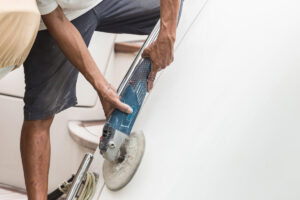Guide to Selling a Yacht
 Yacht Broker Basics / Knowing Your Broker
Yacht Broker Basics / Knowing Your Broker
Yacht Brokers work like real estate agents. They are agents who people consult to find and purchase a boat, and who people hire to market, represent, and sell boats for them. Yacht Brokers are paid by the seller at the completion of the sale. A yacht broker earns his sales commission by marketing and successfully selling a client’s yacht. Yacht Broker are not paid a salary or wage. He only earns income by diligently marketing a client’s boat until it sells, and the transaction is complete. A broker’s time and expertise are his only ‘inventory’, and since 95% of his or her time does not result in a completed transaction, a broker must be careful where he invests his time. If you want the best broker available to assist you with your search and evaluation, you will be best served by establishing some mutual loyalty so that the broker will be incentivized to go the extra mile for you to dig for the facts about a target boat and to make inquiries on your behalf.
Although a yacht broker may originally have a relationship with the seller, brokers have a duty to fairly represent the interests of both the buyer and the seller in every transaction. It takes a balanced and knowledgeable approach, and an ability to manage partially competing interests to bring a transaction together to all the parties’ satisfaction.
As a buyer, it is in your best interest to select an experienced yacht broker to assist you in identifying and evaluating a yacht and to have that yacht broker represent you in your inquiries and transactions. It doesn’t cost you anything extra, since commissions are paid by the sellers, and if you connect with a professional and knowledgeable yacht broker, he can deliver a huge benefit to you in finding and evaluating the right boat and coordinating a transaction that will be guided by a predictable and satisfactory process.
A good yacht broker typically has a portfolio of yachts that he represents and markets and the scope of his portfolio of represented yachts will suggest the scope and depth of his expertise. If a broker is representing primarily 30 to 50 foot vessels, he won’t be much of a resource for you in evaluating a 80 foot or larger motor yacht. It takes years to develop expertise in the more complex systems installed in larger yachts, and to understand the dynamics associated with flag state and classification selection.
Don’t be afraid to ask questions of your broker, to measure his willingness to give you straight answers and his apparent ability to help you effectively deal with the technical and legal issues related to your proposed purchase or sale.
Preparing Your Yacht for Sale
The best way to get the best sale price for your vessel and minimize the length of time that it’s on the market is to prepare the boat so that a prospective purchaser and their surveyor will walk aboard and immediately be impressed. If there are obvious defects, if the vessel is dirty whether inside or outside, a surveyor will assume that there are likely to be numerous hidden defects also. It is hard for a seller to support top value these days with so many boats available on the market. You’ll have a quicker sale and be able to get the most money if your boat is clean and competes well against other boats of similar size, age and style in your geographical area as well as the worldwide market.
Keeping up with your maintenance during the term of your ownership and a little remedial work when you’re ready to sell will help your boat look its best and bring the best results.
- Assemble all ownership materials, including Registration Documents, Customs or Port Control check-in papers, Maintenance Records, General Arrangement or Layout diagram, Builder’s Certificate, Options List, Condition Surveys that you or a previous owner may have had conducted. Assemble maintenance records either by item or vessel location and have them in labeled folders in an easy to carry folder box.
- Provide us with copies of the registration, title or Certificate of Documentation along with any surveys and we can then research comparable market data and establish ideal market positioning to ensure that the boat competes favorably.
- Remove unnecessary items from the vessel including personal effects and clutter. The boat should be staged like a new boat would be, with clean linens on the berths and all berths made, towels in place in the heads and galley, and some nice touches that make the boat attractive and appealing to someone coming aboard who is trying to imagine showing the boat proudly to their friends & family.
- Fix items that are not operational. Spending a little bit of money now will help you to not get beat up for a survey allowance after survey.
- Conduct your own trial run, preferably with a qualified mechanic who will test all systems for full operation and supply a written report. Engines should be able to reach their rated RPM’s at wide open throttle (WOT) and not overheat.
- Correctly state the vessel’s cruising speed with fuel consumption & top speed with fuel consumption data. Calculate range in nautical miles with a full tank of fuel.
- Sailing vessels should have the rig inspected and a report provided by a rigger. Make any necessary sail and canvas repairs.
- Only list safety items that are within the expiry date.
- Conduct minor cosmetic repairs.
- Clean the boat thoroughly inside & out, scheduling regular wash downs and airings to keep the boat in top shape.
- Have the topsides and superstructure waxed.
- Have the interior hull sides and bottom cleaned in the engine room and ideally, painted.
- Replace all burned out light bulbs and ensure all heads, sumps, drains, bilge pumps, appliances, etc. are cleaned and operable.
Consider employing a qualified marine surveyor to conduct a “General Condition Survey” to reveal possible maintenance items that should be addressed so that the vessel presents better in a full Pre-purchase Condition Survey.


Preparing Your Yacht Pre-Purchase Survey
You now have been able to generate an offer and a signed sales contract and the buyer is now organizing the pre-purchase survey as well as a possible mechanical inspection.
A pre-purchase survey is the culmination and the objective of all of the work that you and your broker have undertaken to sell your boat. This in-depth examination, which is similar to a home inspection, of your yacht and can make or break the sale of your vessl.. Preparing for the survey should now be a high priority.
Before a house inspection people know to mow the lawn, de-clutter the house, bake bread and brew coffee.
So how should you prepare your boat for a pre-purchase survey?
Assemble relevant documentation for the buyer’s broker & surveyor to review. This is a simplified list. Please contact us for a detailed checklist of required documentation.
- Ship’s papers (Flag State Certificate, state title or certificate of documentation.
- For larger yachts, a Vessel Classification Society certificates should be on board the vessel.
- International check in papers (Marine Dept. & Customs).
- General Arrangement drawings, stability book and other construction design documents
- Access to the vessel’s manuals.
- A detailed ship’s inventory and service history.
- A list of any known deficiencies.
- Certificates for all recent safety equipment inspections (life raft, fire suppression systems, EPIRB etc.).
- Engine maintenance and service records.
Prior to the survey inspection ensure:
- Reasonable access to all the vessel’s systems.
- Stock the fridge with icy cold bottles of water for the buyers and surveyor.
- Open all curtains and blinds
- Turn on all lights, including in the engine room.
- Turn on all air conditioning units on high (or heat, depending on season)
- Cabin sole boards are made removable.
- Sea cocks & through hull fittings are in good condition.
- Raw water hoses are double clamped and rusty clamps are replaced as necessary.
- Bilge pumps and float switches are operational.
- Bilges are clean & dry.
- Tanks are accessible for inspection.
- Safety equipment is displayed for inspection.
- The fire suppression systems are serviced as per the manufacturer’s recommendations.
- Engine(s) are operational.
- Exhaust systems are in good condition. All hose ends must be double clamped.
- Anchor winches are operational.
- Electrical systems (AC & DC) are operational.
- Navigation and communication equipment is in good condition and operational.
- Sails, winches and running rigging are ready for inspection.
- Underwater hull surfaces and drive gear are clean of marine growth.
- There is adequate fuel for a two hour trial run (if a trial run is required).
If you pay attention to these suggestions , you’ll have a successful survey and the buyer and his surveyor will have little to note as defective. This is a guide only and not a complete list of guaranteed items that will make your vessel pass survey with a 100% score. You as the owner will also have to use your own common sense as what needs to be done. The best way to approach this is to think back to when you bought the boat and what did you look for.
